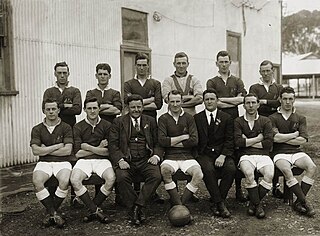
John Dyson is a former international cricketer (batsman) who is now a cricket coach, most recently in charge of the West Indies.

Percy Stanislaus McDonnell was an Australian cricketer who captained the Australian Test team in six matches, including the tour of England in 1888.

Alfred Percy Marr was an Australian cricketer who played in one Test match in 1885.

In Queensland, Australian rules football dates back to the colonial era in 1866, with organised competitions being continuous since the 1900s. Today, it is most popular in South East Queensland and the Cairns Region. There are 11 regional club competitions, the highest profile of which are the semi-professional Queensland Australian Football League and AFL Cairns. It is governed by AFL Queensland which has more than 55,000 registered adult players.

Percival Mitchell Hornibrook was an Australian cricketer who played in six Test matches from 1929 to 1930.
Alan David Ogilvie is a former Australian cricketer who played in five Tests from 1977 to 1978 during World Series Cricket.
North Ipswich Reserve, known as Qld Group Stadium or commercially Bendigo Bank Oval, is a sports venue in Ipswich, Queensland. Originally an Australian rules football oval, it became a primarily rugby league venue in the 1920s as that code experienced an explosion in local popularity. It is currently home to the Ipswich Jets, who play in the Queensland Wizard Cup. On occasion the venue plays host to National Rugby League trial matches, most recently when the Sydney Roosters played the Jets.
The Brisbane Football Club is a defunct football club, formed in May 1866 in the colonial capital of Brisbane. Brisbane FC was the first known football club of any code in the Colony of Queensland. It was the first club outside Victoria to adopt what was then known as the 'Victorian rules' football from 1866. It is also the first recorded club to have played multiple football codes in Queensland, including soccer (1867–1875) and rugby (1876–1879).

Patrick James S. "Paddy" Carew was an Australian rugby union national and state representative and a first-class cricketer and public servant. He was born in Pine Mountain in southern Queensland.
Alex Gibb was an Australian soccer player who played half-back with Queensland clubs and the Queensland and Australia national teams. Gibb is recognised as Australia's first international captain, and was awarded Socceroo cap number one retrospectively in 2000 by Football Federation Australia, for Australia's first Test match against New Zealand, played in 1922.
John Muir Peebles was an Australian soccer player, official, and administrator.
William "Podge" Maunder was an Australian soccer player. Maunder is recognised as the player who scored Australia's first international goal.
Percy Lennard (1900–1975) was an Australian soccer player.
Grange Thistle is an Australian association football club based in Grange, Queensland. In 2024, the club fielded 12 senior teams and more than 95 junior teams. Both senior teams compete in the Football Queensland Premier League 2.
The 1932 Great Britain Lions tour was a tour by the Great Britain national rugby league team) of Australia and New Zealand which took place between May and August 1932. The tour involved a schedule of 26 games, 18 in Australia including a three-test series against Australia for the Ashes and a further eight in New Zealand including a three-test series against New Zealand.
Jack White was a former Australian professional soccer player who last played as a half-back for Cairns. Often considered a versatile player, he was a selection three times for the Australia national soccer team.
Jack Gilmore was a former Australian professional soccer player who played as a forward for NSW club Weston and the Australia national soccer team.

This article summarises the Australia men's national soccer team in 1922.

This article summarises the Australia men's national soccer team in 1924.
This article summarises the Australia men's national soccer team in 1933.







